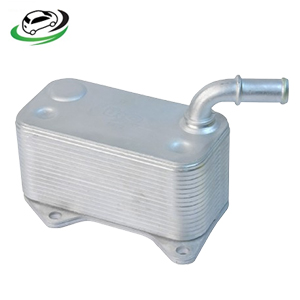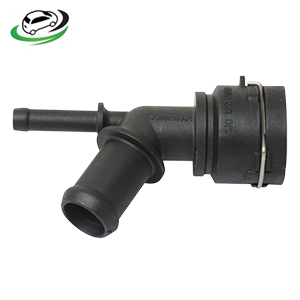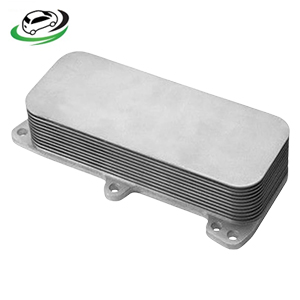-7%
Get Engine Oil Cooler Volkswagen Califonia T5 Camper/Multivan T5/Touareg (7LA/7L6/7L7)/Transporter T5 070117021D
The engine oil cooler is an essential component in modern engines, designed to regulate the temperature of engine oil and maintain optimal engine performance. This guide provides a comprehensive overview of the engine oil cooler’s function, construction, types, symptoms of issues, diagnosis, and replacement.
What is an Engine Oil Cooler?
An engine oil cooler is a component that helps manage the temperature of the engine oil. By cooling the oil, the cooler ensures that the oil maintains its optimal viscosity and performance, preventing overheating and ensuring the engine operates efficiently. The cooler is typically integrated into the engine’s cooling system and works in conjunction with the radiator to maintain the engine’s temperature within a safe range.
Functions of the Engine Oil Cooler
The engine oil cooler performs several crucial functions in maintaining engine health and performance:
- Temperature Regulation: The primary function of the engine oil cooler is to regulate the temperature of the engine oil. Engine oil can reach high temperatures during operation, especially under heavy load or high-performance conditions. The cooler helps to maintain the oil at a temperature that ensures it remains effective in lubricating and protecting engine components.
- Preventing Oil Breakdown: High temperatures can cause engine oil to break down more quickly, reducing its effectiveness and leading to potential engine damage. The oil cooler helps to prevent oil breakdown by keeping the oil within a safe temperature range, extending the life of the oil and engine components.
- Enhancing Engine Performance: By maintaining optimal oil temperatures, the engine oil cooler helps ensure that the engine performs at its best. Properly cooled oil contributes to smoother engine operation, better fuel efficiency, and improved overall performance.
- Reducing Engine Wear: Engine oil that operates at the correct temperature provides better lubrication and protection for engine components. The oil cooler helps to reduce engine wear and tear by ensuring that the oil remains effective in reducing friction and preventing component damage.
- Improving Cooling System Efficiency: In some engine designs, the oil cooler is integrated with the engine’s cooling system. By transferring heat from the oil to the coolant, the oil cooler helps to improve the overall efficiency of the cooling system, contributing to better engine temperature management.
Construction of the Engine Oil Cooler
The engine oil cooler consists of several key components that work together to regulate oil temperature:
- Cooler Core: The cooler core is the primary component of the engine oil cooler, where the oil is cooled. It typically consists of a series of small passages or fins that allow heat transfer from the oil to the coolant or air. The core is often made from aluminum or other heat-conductive materials.
- Oil Inlet and Outlet Ports: The engine oil cooler has oil inlet and outlet ports that connect to the engine’s oil system. The inlet port allows hot oil to enter the cooler, while the outlet port allows cooled oil to return to the engine.
- Coolant or Air Passage: Depending on the type of oil cooler, it may have passages for coolant or air. In air-cooled oil coolers, the core is exposed to airflow from the engine or vehicle’s front grille. In liquid-cooled oil coolers, the core is connected to the engine’s cooling system, allowing coolant to flow through the cooler and absorb heat from the oil.
- Mounting Brackets: The oil cooler is mounted to the engine or chassis using brackets or fasteners. These brackets ensure that the cooler is securely positioned and aligned with the engine’s oil system.
- Thermostatic Control Valve: Some engine oil coolers are equipped with a thermostatic control valve that regulates the flow of oil through the cooler based on temperature. The valve opens or closes to maintain the oil at the desired temperature range.
Types of Engine Oil Coolers
Engine oil coolers come in different types based on their cooling mechanism:
- Air-Cooled Oil Coolers: Air-cooled oil coolers use airflow to dissipate heat from the engine oil. The cooler core is exposed to the ambient air, and heat is transferred from the oil to the air as the vehicle moves. This type of cooler is often used in high-performance or off-road vehicles where additional cooling is required.
- Liquid-Cooled Oil Coolers: Liquid-cooled oil coolers use the engine’s coolant to absorb heat from the oil. The cooler core is integrated into the engine’s cooling system, allowing coolant to flow through the cooler and transfer heat from the oil. This type of cooler is commonly used in passenger vehicles and provides more efficient cooling compared to air-cooled systems.
- Combined Oil Coolers: Some engines use a combined oil cooler that incorporates both air and liquid cooling. This type of cooler utilizes airflow and coolant to provide enhanced cooling performance. It is often found in high-performance engines or vehicles that experience extreme operating conditions.
- External Oil Coolers: External oil coolers are standalone units that are mounted separately from the engine. They are connected to the engine’s oil system via hoses and provide additional cooling capacity. External oil coolers are often used in racing applications or vehicles with modified engines that generate higher heat.
Symptoms of Issues with the Engine Oil Cooler
Problems with the engine oil cooler can lead to various symptoms affecting engine performance and reliability. Common symptoms of issues include:
- Overheating: If the engine oil cooler is not functioning properly, the engine oil may overheat. Symptoms of overheating include a higher-than-normal engine temperature gauge reading or warning lights indicating overheating.
- Low Oil Pressure: A malfunctioning oil cooler can lead to reduced oil pressure. This may result in warning lights on the dashboard or unusual engine noise due to insufficient lubrication.
- Oil Leaks: Leaks around the oil cooler, especially at the inlet and outlet ports, can indicate a problem with the cooler or its connections. Oil leaks can lead to low oil levels and potential engine damage.
- Poor Engine Performance: If the oil cooler is not effectively cooling the oil, you may experience reduced engine performance, including decreased power, poor acceleration, or increased fuel consumption.
- Coolant Contamination: In liquid-cooled oil coolers, a malfunctioning cooler can cause coolant to mix with engine oil. This contamination can lead to a milky appearance in the oil or coolant and may indicate a failure of the cooler’s internal seals.
Diagnosing Issues with the Engine Oil Cooler
Diagnosing issues with the engine oil cooler involves several steps:
- Visual Inspection: Perform a visual inspection of the oil cooler and its connections. Look for signs of oil leaks, coolant leaks, or physical damage to the cooler core or mounting brackets.
- Check Oil Temperature: Monitor the engine oil temperature using a gauge or diagnostic tool. Compare the readings to the manufacturer’s specifications to determine if the oil is operating within the recommended temperature range.
- Inspect Oil Pressure: Measure the engine oil pressure using a gauge. Compare the readings to the manufacturer’s specifications to identify any potential issues with oil pressure.
- Check Coolant for Contamination: Inspect the coolant for signs of oil contamination, such as a milky appearance or oil floating on top. This can indicate a problem with the oil cooler.
- Use Diagnostic Tools: Use diagnostic tools or scanners to check for any error codes related to the oil cooler or engine temperature. The codes can provide insights into potential issues.
Replacing the Engine Oil Cooler
If a problem with the engine oil cooler is identified, replacing it is necessary to restore proper engine function. The replacement process typically involves the following steps:
- Prepare the Vehicle: Ensure the engine is cool before starting the replacement process. Disconnect the battery to prevent electrical issues. Drain the engine oil and coolant if necessary.
- Locate the Oil Cooler: Locate the engine oil cooler and its connections. The cooler is usually mounted to the engine block or radiator.
- Remove the Old Oil Cooler: Disconnect the oil lines or hoses from the oil cooler. Remove any mounting bolts or fasteners securing the cooler to the engine. Carefully extract the old cooler from its mounting location.
- Install the New Oil Cooler: Position the new oil cooler in the mounting location, ensuring proper alignment with the oil lines and engine. Secure the cooler with the appropriate bolts or fasteners.
- Reconnect Oil Lines: Reconnect the oil lines or hoses to the new cooler. Ensure that the connections are tight and free from leaks.
- Refill Oil and Coolant: Refill the engine with the appropriate type and amount of oil and coolant. Bleed the cooling system if necessary to remove any air pockets.
- Check Operation: Start the engine and monitor the oil cooler for any signs of leaks or issues. Check the oil and coolant levels and ensure that the engine operates smoothly.
Choosing the Right Engine Oil Cooler
When selecting a replacement oil cooler, consider the following factors:
- OEM vs. Aftermarket: OEM (Original Equipment Manufacturer) oil coolers are designed to meet the exact specifications of your vehicle and provide reliable performance. Aftermarket coolers can vary in quality, so choose a reputable brand if opting for an aftermarket part.
- Compatibility: Ensure that the oil cooler is compatible with your vehicle’s make, model, and engine configuration. Verify the part number and specifications before making a purchase.
- Material and Design: Choose an oil cooler made from durable materials that can withstand the engine’s operating conditions. Consider the design of the cooler, including its cooling mechanism and mounting features, to ensure proper fit and function.
Follow us on Facebook for more parts.



